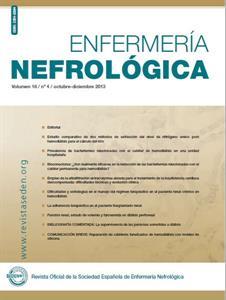Main Article Content
Abstract
Patients starting renal replacement therapy are increasingly elderly, representing a further deterioration of the vascular network that is affecting the development of internal arteriovenous fistula. This implies an increase in the use of tunneled catheters. The physical deterioration of the catheter sometimes leads to its replacement, compromising patient safety and unnecessary increasing health costs of treatment. To avoid this, we evaluate the use of peritoneal catheter repair kits in tunneled catheters, performing a retrospective study in a population of three patients to whom a leak was detected in the path of their catheters. The running time of these catheters after repair was variable, ranging from 9 months to more than 3 years, being one of them still in use. Their withdrawal was not related in any way with the technique of repair performed and there was only a minor complication in one case, what confirms the effectiveness of the technique developed and the consequent saving in material and human resources.
Keywords
Repairing
tunnelled haemodialysis
SILICON
Article Details
License
Author copyright notice
© Authors grant the publisher the non-exclusive licence to publish the work and consent to its use and distribution under the Creative Commons Attribution - NonCommercial 4.0 International (CC BY-NC 4.0) licence. Read the licensing information and the legal text here. This must be expressly stated wherever necessary.
How to Cite
1.
Alarcia Martín A, Brázalez Tejerina M, Franco Valdivieso C, Melero Salas L, Rollán de la Sota MJ. Repairing tunnelled haemodialysis catheters with silicon moulds. Enferm Nefrol [Internet]. 2014 [cited 2025 Dec 15];16(4):[about 3 p.]. Available from: https://enfermerianefrologica.com/revista/article/view/4179




